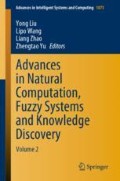Abstract
With the rapid development of information technology, more and more people use social networks to express their opinions. Therefore, it is of great significance to establish appropriate model for prediction of information dissemination. Because the physical meaning of the fractional model is clearer, its expression is simpler, therefore, the fractional SEIRS model based on the conformable derivative is introduced in this study, which is more matches the true situation. Taking the forwarding amount of the eighth question of the 2018 college entrance examination as an example, the fractional SEIRS model is used for data fitting. And the results show that the model fitting curve is basically consistent with the real data curve, the SEIRS model in this study has an important guiding role in predicting the trend of information dissemination.
Access this chapter
Tax calculation will be finalised at checkout
Purchases are for personal use only
References
Guang-lan, W.: Stability Analysis of SIR Space-Time Network Rumor Propagation Model. J. Kunming Univ. Sci. Technol. (Nat. Sci.) 43(01), 126–132 (2018)
Xiao-hong, Z., Kai, Q., Ya-lei, B.: Information dissemination model of device-to-device communication in mobile social networks based on SIR. J. Henan Polytech. Univ. (Nat. Sci.) 38(3), 131–136 (2019)
Miao, G., Yuansheng, J.: Preve analysis of micro-blog information forwarding under the background of network public opinion dissemination and evolution. J. Intell. 35(05), 46–51, 37 (2016)
Cui, J.-D., Zheng, Q., Sun, S.: Research on micro-blog topic information dissemination based on improved SEIR model. Inf. Sci. 35(12), 22–27 (2017)
Jian-Hua, Z., Ke-Wen, W.: Research on the communication dynamics model of social network public opinion based on the SIS model. Inf. Sci. 35(12), 34–38 (2017)
Que, Z.: Research on information spread mechanism of micro-blog based on information ecology. Northeast Electric Power University (2018)
Zhang, J., Wei, Z., et al.: Analytical solution for the time fractional BBM-burger equation by using modified residual power series method. Complexity 2018, 1–11 (2018)
Khalil, R., Horani, M.A., Yousef, A., et al.: A new definition of fractional derivative. J. Comput. Appl. Math. 264(5), 65–70 (2014)
Javeed, S., Saif, S., Waheed, A., et al.: Exact solutions of fractional BBM equation and coupled system of fractional Boussinesq-Burgers. Results Phys. 9, 1275–1281 (2018)
Yang, S., Wang, L., Zhang, S.: Conformable derivative: application to non-Darcian flow in low-permeability porous media. Appl. Math. Lett. 79, 105–110 (2017)
Abdeljawad, T.: On conformable fractional calculus. J. Comput. Appl. Math. 279, 57–66 (2015)
Kermack, W.O., McKendrick, A.G.: Bull. Math. Bio. 53, 33 (1991)
Acknowledgments
Construction of Special Funds for Key Disciplines in Shaanxi Universities, Science Foundation of the Shaanxi Key Laboratory of Network Data Analysis and Intelligent Processing, the Natural Science Foundation of Shaanxi Province (2018JM1055). National Civil Affairs Commission National Research Project (2018-GME-010), Shaanxi Province Key Research and Development Program (2018GY-150), Xi’an Science and Technology Plan Project (201805040YD18CG24-3), Shaanxi Province Key Laboratory of Network Data Analysis and Intelligent Processing (XUPT-KLND (201806)).
Author information
Authors and Affiliations
Corresponding authors
Editor information
Editors and Affiliations
Rights and permissions
Copyright information
© 2020 Springer Nature Switzerland AG
About this paper
Cite this paper
Tong, Q., Wang, H., Zhang, J., Li, L., Huang, Q. (2020). The Fractional SEIRS Epidemic Model for Information Dissemination in Social Networks. In: Liu, Y., Wang, L., Zhao, L., Yu, Z. (eds) Advances in Natural Computation, Fuzzy Systems and Knowledge Discovery. ICNC-FSKD 2019. Advances in Intelligent Systems and Computing, vol 1075. Springer, Cham. https://doi.org/10.1007/978-3-030-32591-6_30
Download citation
DOI: https://doi.org/10.1007/978-3-030-32591-6_30
Published:
Publisher Name: Springer, Cham
Print ISBN: 978-3-030-32590-9
Online ISBN: 978-3-030-32591-6
eBook Packages: Intelligent Technologies and RoboticsIntelligent Technologies and Robotics (R0)

